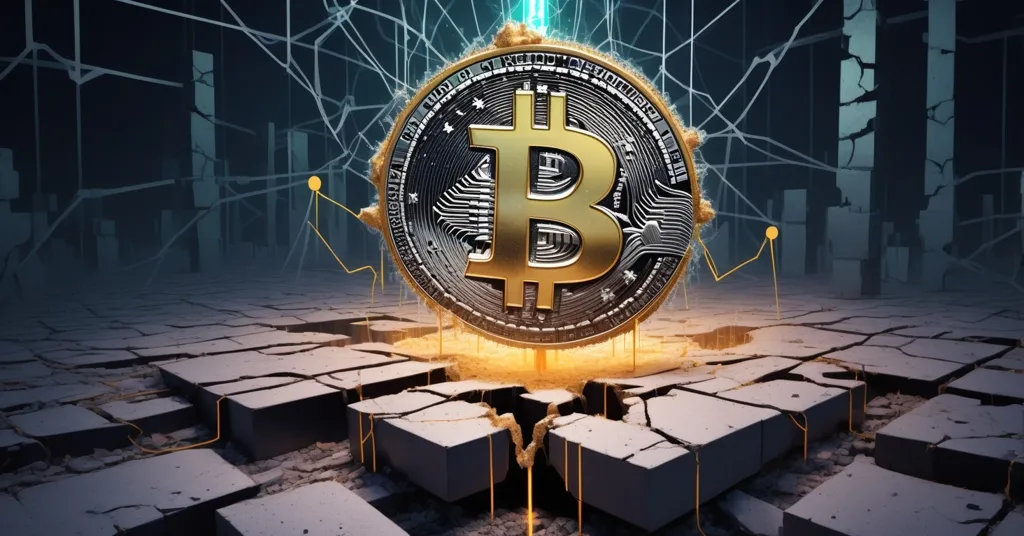US Credit Downgrade to AA-: Fiat Falters, Bitcoin’s Appeal Surges

US Credit Rating Downgrade to AA-: Fiat’s Cracks Deepen, Bitcoin’s Case Strengthens
Scope Ratings, a Berlin-based credit agency, has slashed the United States’ credit rating from AA to AA-, sounding a piercing alarm over deteriorating public finances and crumbling governance. With Washington mired in budget standoffs and debt spiraling toward unsustainable heights, this downgrade isn’t just a financial footnote—it’s a glaring signal of fiat fragility that could propel Bitcoin and decentralized systems into the spotlight as viable alternatives.
- Downgrade Snapshot: US rating cut to AA- from AA, three tiers below Scope’s top grade.
- Root Causes: Persistent fiscal decline and governance failures, fueled by political gridlock.
- Crypto Relevance: Does this expose fiat’s weaknesses enough to accelerate Bitcoin adoption?
Understanding the Downgrade: A Financial Red Flag
The decision by Scope Ratings, recognized by the European Central Bank for collateral valuation, marks a stark departure from the long-held view of the US as the unassailable pillar of global finance. Their blunt reasoning—a “sustained deterioration in public finances and a weakening of governance standards”—cuts through the illusion of economic invincibility, as detailed in their recent assessment of worsening US public finances. For those new to the game, a credit rating is like a trustworthiness score for a country’s debt. A high rating (think AAA) means lenders feel confident about getting repaid; a drop to AA- signals rising doubt, potentially spooking markets and hiking borrowing costs. Scope’s downgrade places the US two notches below assessments from giants like Fitch, Moody’s, and S&P Global, with Moody’s already having demoted the US to Aa1 from Aaa in May 2025 over similar debt concerns.
The numbers paint an even grimmer picture. The International Monetary Fund (IMF) projects US gross debt to swell from 125% of GDP in 2025 to a jaw-dropping 140% by 2029. To put that in perspective, debt-to-GDP is like gauging how much a household owes compared to its yearly income—a higher ratio means heavier burden. The US is outpacing notoriously indebted nations like Italy and Greece, a trajectory that screams fiscal irresponsibility. Scope isn’t alone in their worry. Their lead analyst, Eiko Sievert, flagged as early as October 2025 a “small but increasing likelihood of a politically induced default” due to Washington’s incessant squabbling over budgets and debt ceilings. This isn’t hypothetical—back in 2011, a similar debt ceiling standoff led S&P to strip the US of its AAA rating, costing billions in higher borrowing expenses.
Fiat’s Fragility: Political Dysfunction Meets Debt Disaster
What’s behind this slow-motion trainwreck? Scope points to a poisonous cocktail of inconsistent fiscal policy and governance breakdowns. Washington’s budget battles, where partisan posturing routinely risks government shutdowns or debt defaults, are less about leadership and more akin to a high-stakes poker game with everyone’s future on the line. Congress plays chicken with debt ceilings as if it’s a sport, ignoring the collateral damage. Moody’s echoed this sentiment during their May 2025 downgrade, stating:
“While we recognize the US’s significant economic and financial strengths, we believe these no longer fully counterbalance the decline in fiscal metrics.”
Even Moritz Kraemer, a former S&P Global sovereign ratings officer, lauded Scope’s move, noting it “reflected courage and fairness in highlighting the erosion of US governance.” Meanwhile, the White House’s response—or lack thereof—reeks of denial. No official comment has emerged on Scope’s downgrade, but their reaction to Moody’s earlier cut was telling. Spokesman Steven Cheung lobbed accusations of political bias at Moody’s Analytics economist Mark Zandi, while US Treasury Secretary Scott Bessent has admitted the “perilous levels” of national debt, warning of an economic crisis. Dodging accountability with cheap shots at analysts isn’t a strategy—it’s a clown show.
Globally, this downgrade chips away at the dollar’s aura as the world’s reserve currency. If trust erodes further, nations like China or BRICS allies might explore alternatives—whether it’s crypto or centralized nightmares like central bank digital currencies (CBDCs), which are just state control dressed up in digital garb. The ripple effects could destabilize markets, and that’s where the conversation pivots to decentralized solutions.
Bitcoin’s Opportunity: A Hedge Against Fiat Failure
For Bitcoin advocates and decentralization diehards, Scope’s downgrade is a neon sign flashing “fiat is broken.” Bitcoin emerged from the 2008 financial meltdown as a middle finger to centralized mismanagement—banks and governments proved they couldn’t be trusted, so a trustless, permissionless system was born. Now, with US debt ballooning and governance in shambles, the narrative of Bitcoin as a hedge against inflation and currency devaluation gains traction. A hedge, simply put, is a protective bet—if the dollar’s value tanks due to debt overload, Bitcoin’s fixed supply of 21 million coins could, in theory, hold its worth better, much like gold has historically during crises. Google Trends data from past debt ceiling dramas, like in 2023, showed spikes in searches for “Bitcoin hedge,” hinting at growing public curiosity during economic uncertainty.
The logic tracks: if the “full faith and credit” of the US government starts looking like a bad joke, why not park value in a system no politician can inflate away? Bitcoin’s decentralized nature means no central bank can print more to cover bad bets, a direct counter to fiat’s endless money printer. When the IMF warns of debt levels that make economists break out in cold sweats, a borderless digital asset starts looking less like a speculative toy and more like a lifeboat.
Challenges Ahead: Bitcoin Isn’t a Magic Bullet
Before we drown in blind optimism, let’s keep it real. Bitcoin maximalists—and I lean that way most days—love to preach it as the ultimate fiat fix, but the hurdles are glaring. Price volatility can give even seasoned hodlers whiplash; one day it’s a safe haven, the next it’s a rollercoaster. Widespread adoption remains a grind—try explaining private keys to your grandma while the dollar still buys her groceries. Regulatory uncertainty looms like a storm cloud; the SEC’s ongoing crusades against projects like Ripple signal a crackdown that could stifle crypto just when it’s poised to shine. Sure, Bitcoin’s price swings induce heartburn, but when fiat debt hits 140% of GDP, “stability” isn’t exactly the dollar’s calling card either.
Then there’s scalability. If a US default—however unlikely—triggers a mass exodus to Bitcoin, can the network handle the load? The Lightning Network, a layer-2 solution for faster transactions, shows promise, but it’s not yet battle-tested at that scale. Infrastructure must catch up to the hype, or the dream of “digital gold” risks becoming a meme.
DeFi and Altcoins: Filling the Gaps Bitcoin Can’t
Bitcoin isn’t the only player in this financial revolution. Ethereum and other blockchain ecosystems offer tools Bitcoin doesn’t touch, especially through decentralized finance (DeFi). DeFi lets users lend, borrow, or trade without banks, using smart contracts—self-executing code on the blockchain—to cut out middlemen. Imagine earning interest on savings via yield farming instead of a bank’s pitiful rates, all while dodging fiat’s sinking ship. Stablecoins on Ethereum, pegged to the dollar’s value, provide a crypto on-ramp without Bitcoin’s wild swings, though hacks and scams remain a neon warning sign.
Other altcoins have their niches too. Solana pushes for faster, cheaper transactions, while Polkadot aims to connect disparate blockchains for seamless interoperability. These projects aren’t Bitcoin competitors—they’re complementary pieces in a broader push to upend traditional finance. If US fiscal crises drive people away from banks, DeFi could explode, assuming it dodges regulatory bullets and patches its own vulnerabilities. The flip side? Every hack or rug pull fuels skepticism, and we can’t pretend centralized systems will roll over without a fight.
Future Outlook: A Tipping Point for Decentralization?
What happens if US debt woes worsen? A politically induced default, even a brief one, could turbocharge Bitcoin’s “digital gold” narrative overnight. Picture millions fleeing fiat uncertainty, piling into crypto as a protest against broken systems. But that’s a double-edged sword—mass adoption could strain networks, spike fees, and invite harsher crackdowns. On the flip side, persistent fiscal irresponsibility might push effective accelerationism into overdrive, where we build faster, freer financial tools not just to react to crises but to outlast them. The fiat empire is cracking; the question is whether crypto can rise without tripping over its own feet.
Key Takeaways and Questions for Crypto Enthusiasts
- What does the US credit downgrade mean for global financial stability?
It casts doubt on the US’s debt management, risking confidence in the dollar and potentially spiking market volatility, which could drive interest in Bitcoin as an alternative. - Can this fiscal crisis boost Bitcoin and crypto adoption?
Yes, as trust in fiat wanes, Bitcoin’s appeal as a hedge against inflation and devaluation grows, though volatility and adoption barriers persist. - Will decentralized finance (DeFi) gain from US governance failures?
Likely, as DeFi on Ethereum and other blockchains offers bank-free financial tools, but scalability and regulatory risks could hinder progress. - Does this reinforce Bitcoin’s founding mission?
Absolutely, it mirrors the distrust in centralized systems that birthed Bitcoin, though we must face its current limitations head-on. - How might this impact the dollar’s global dominance?
Eroding trust could push nations and investors toward alternatives like crypto or CBDCs, though the latter risks entrenching centralized control. - Could CBDCs compete with crypto in a fiat crisis?
Possibly, as governments push digital currencies for control, but their centralized nature clashes with crypto’s ethos of freedom and privacy.
Scope Ratings’ downgrade isn’t just a slap on the wrist for the US—it’s a wake-up call for anyone still clinging to fiat’s supposed safety. As debt spirals and political games drag on, the argument for Bitcoin and decentralized tech grows undeniable. But the burden is on us to keep it real, cut through the hype, and build solutions that don’t just capitalize on fiat’s failures but redefine what money can be. Are you ready to rethink what “safe” really means in a world where the old guard is stumbling?



